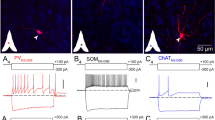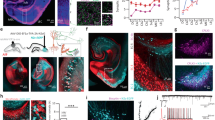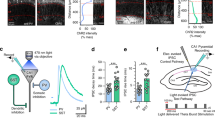Abstract
In the hippocampus, which is phylogenetically older than the cerebral neocortex, high frequency stimulation of afferent pathways leads to long-term potentiation (LTP) of synaptic transmission1–5. This use-dependent malleability is of considerable interest because it may serve as a substrate for memory processes. However, in the neocortex, whose involvement in learning is undisputed, attempts to demonstrate LTP have remained inconclusive6–8. Here we use intracellular recording techniques to show that LTP can be induced by high frequency stimulation of the optic radiation in slices of the visual cortex of adult rats. We identify as a necessary prerequisite for the induction of LTP the activation of the membrane channel that is associated with the NMDA (N-methyl-D-aspartate) receptor. Selective blockade of this receptor system with DL-2-amino-5-phosphonovalerate consistently prevents LTP as in most hippocampal pathways9–11. In most cortical neurons the activation of the NMDA mechanism and hence the induction of LTP in these experiments requires a concomitant reduction of GABAergic inhibition by low doses of the GABAA antagonist bicuculline. This indicates that in the neocortex the activation threshold of the NMDA-mechanism and consequently the susceptibility to LTP, are strongly influenced by inhibitory processes.
This is a preview of subscription content, access via your institution
Access options
Subscribe to this journal
Receive 51 print issues and online access
$199.00 per year
only $3.90 per issue
Buy this article
- Purchase on Springer Link
- Instant access to full article PDF
Prices may be subject to local taxes which are calculated during checkout
Similar content being viewed by others
References
1. Bliss, T. V. P. & Lomo, T. J. PhysioL 232, 331-356 (1973). 2. Schwartzkroin, P. A. & Wester, K. Brain Res. 89, 107-119 (1975). 3. Alger, B. E. & Teyler, T. J. Brain Res. 110, 463-480 (1976). 4. Dunwiddie, T. & Lynch, G. J. Physiol. 276, 353-367 (1978). 5. Andersen, P., Sundberg, S. H., Sveen, O., Swann, J. W. & Wigstrom, H. /. Physiol. 302, 463-482 (1980). 6. Komatsu, Y., Toyama, K., Maeda, J. & Sakaguchi, H. Neurosci. Lett. 26, 269-274 (1981). 7. Lee, K. S. Brain Res. 239, 617-623 (1982). 8. Bindman, L. J., Meyer, T. & Pockett, S. J. Physiol. 386, 90P (1987). 9. Collingridge, G. L., Kehl, S. J. & McLennan, H. / PhysioL 334, 33-46 (1983). 10. Wigstrom, H. & Gustafsson, B. Neurosci. Lett. 44, 327-332 (1984). 11. Harris, E. W., Ganong, A. H. & Cotman, C. W. Brain Res. 323, 132-137 (1984). 12. McCormick, D. A., Connors, B. W., Lighthall, J. W. & Prince D. A. J. Neurophysiol. 54, 782-806 (1985). 13. Connors, B. W., Gutnick, M. J. & Prince, D. A. J. Neurophysiol. 48, 1302-1320 (1982). 14. Nowak, L., Bregestovski, P., Ascher, P., Herbet, A. & Prochiantz, A. Nature 307, 462-465 (1984). 15. Mayer, M. L., Westbrook, G. L. & Guthrie, P. B. Nature 309, 261-263 (1984). 16. Herron, C. E., Williamson, R. & Collingridge, G. L. Neurosci. Lett. 61, 255-260 (1985). 17. Dingledine, R., Hynes, M. A. & King, G. L. J. Physiol. 380, 175-189 (1986). 18. Hablitz, J. J. & Langmoen, I. A. J. Neurosci. 6, 102-106 (1986). 19. Herron, C. E., Lester, R. A. J., Coan, E. J. & Collingridge, G. L. Neurosci. Lett. 60, 19-23 (1985). 20. Thomson, A. M. J. Physiol. 370, 531-549 (1986). 21. Herron, C. E., Lester, R. A. J., Coan, E. J. & Collingridge, G. L. Nature 322, 265-268 (1986). 22. Wigstrom, H. & Gustafsson, B. Nature 301, 603-604 (1983). 23. MacDermott, A. B., Mayer, M. L., Westbrook, G. L., Smith, S. J. & Barker, J. L. Nature 321, 519-522 (1986). 24. Ascher, P. & Nowak, L. /. Physiol. 377, 35P (1986). 25. Wong, R. K. S. & Prince, D. A. Brain Res. 159, 385-390 (1978). 26. Lynch, G., Larson, J., Kelso, S., Barrionuevo, G. & Schottler, F. Nature 305,719-721 (1983). 27. Geiger, H. & Singer, W. Expl Brain Res. Ser. 14, 256-270 (1986). 28. Greuel, J. M., Luhmann, H. J. & Singer, W. Devl Brain Res. 34, 141-149 (1987). 29. Kleinschmidt, A., Bear, M. F. & Singer, W. Science 238, 355-358 (1987). 30. Singer, W. in The neural and molecular bases of learning (eds Changeux, J.-P. & Konishi M.) 301-336 (Wiley, Chichester, 1987).
Author information
Authors and Affiliations
Rights and permissions
About this article
Cite this article
Artola, A., Singer, W. Long-term potentiation and NMDA receptors in rat visual cortex. Nature 330, 649–652 (1987). https://doi.org/10.1038/330649a0
Received:
Accepted:
Issue Date:
DOI: https://doi.org/10.1038/330649a0
This article is cited by
-
The 1980s: d-AP5, LTP and a Decade of NMDA Receptor Discoveries
Neurochemical Research (2019)
-
LTD-like molecular pathways in developmental synaptic pruning
Nature Neuroscience (2016)
-
Neural plasticity and concepts ontogeny
Synthese (2016)
-
New insights into the role of GABAergic inhibition during functional reorganization of the visual cortex post-lesion
e-Neuroforum (2014)
-
A1R–A2AR heteromers coupled to Gs and Gi/0 proteins modulate GABA transport into astrocytes
Purinergic Signalling (2013)
Comments
By submitting a comment you agree to abide by our Terms and Community Guidelines. If you find something abusive or that does not comply with our terms or guidelines please flag it as inappropriate.



